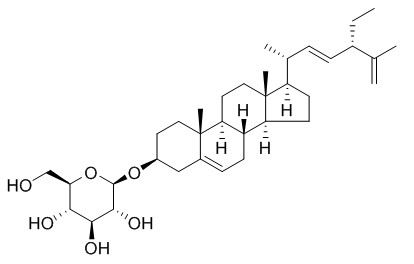22-Dehydroclerosterol glucoside
22-Dehydroclerosterol, and cholesterol are sterol constituents.
Inquire / Order:
manager@chemfaces.com
Technical Inquiries:
service@chemfaces.com
Tel:
+86-27-84237783
Fax:
+86-27-84254680
Address:
1 Building, No. 83, CheCheng Rd., Wuhan Economic and Technological Development Zone, Wuhan, Hubei 430056, PRC
Providing storage is as stated on the product vial and the vial is kept tightly sealed, the product can be stored for up to
24 months(2-8C).
Wherever possible, you should prepare and use solutions on the same day. However, if you need to make up stock solutions in advance, we recommend that you store the solution as aliquots in tightly sealed vials at -20C. Generally, these will be useable for up to two weeks. Before use, and prior to opening the vial we recommend that you allow your product to equilibrate to room temperature for at least 1 hour.
Need more advice on solubility, usage and handling? Please email to: service@chemfaces.com
The packaging of the product may have turned upside down during transportation, resulting in the natural compounds adhering to the neck or cap of the vial. take the vial out of its packaging and gently shake to let the compounds fall to the bottom of the vial. for liquid products, centrifuge at 200-500 RPM to gather the liquid at the bottom of the vial. try to avoid loss or contamination during handling.
South African Journal of Botany2021, 142:114-123.
New Zealand J. Forestry Sci.2014, 44:17
Immunopharmacol Immunotoxicol.2024, 46(4):496-508.
Journal of Functional Foods2022, 96: 105216.
Naunyn Schmiedebergs Arch Pharmacol.2024, 03148-x.
J. Essential Oil Research2024, 6:36:554-565.
Exp Parasitol.2015, 153:160-4
Appl. Sci.2020, 10(8),2804
British Jou. Med.&Med. Research2014, 1802-1811
Int J Mol Sci.2022, 23(21):13406.
Related and Featured Products
Lipids, 2000, 35(3):279-288.
Biosynthesis of sterols and ecdysteroids in Ajuga hairy roots.[Reference:
WebLink]
Hairy roots of Ajuga reptans var. atropurpurea produce clerosterol, 22-dehydroclerosterol(22-Dehydroclerosterol glucoside
), and cholesterol as sterol constituents, and 20-hydroxyecdysone, cyasterone, isocyasterone, and 29-norcyasterone as ecdysteroid constituents. To better understand the biosynthesis of these steroidal compounds, we carried out feeding studies of variously 2H- and 13C-labeled sterol substrates with Ajuga hairy roots. In this article, we review our studies in this field.
METHODS AND RESULTS:
Feeding of labeled desmosterols, 24-methylenecholesterol, and 13C2-acetate established the mechanism of the biosynthesis of the two C29-sterols and a newly accumulated codisterol, including the metabolic correlation of C-26 and C-27 methyl groups. In Ajuga hairy roots, 3α-, 4α-, and 4β-hydrogens of cholesterol were all retained at their original positions after conversion into 20-hydroxyecdysone, in contrast to the observations in a fern and an insect. Furthermore, the origin of 5β-H of 20-hydroxyecdysone was found to be C-6 hydrogen of cholesterol exclusively, which is inconsistent with the results in the fern and the insect. These data strongly support the intermediacy of 7-dehydrocholesterol 5α,6α-epoxide. Moreover, 7-dehydrocholesterol, 3β-hydroxy-5β-cholest-7-en-6-one (5β-ketol), and 3β,14α-dihydroxy-5β-cholest-7-en-6-one (5β-ketodiol) were converted into 20-hydroxyecdysone. Thus, the pathway cholesterol→7-dehydrocholesterol→7-dehydrocholesterol 5α,6α-epoxide→5β-ketol→5β-ketodiol is proposed for the early stages of 20-hydroxyecdysone biosynthesis. 3β-Hydroxy-5β-cholestan-6-one was also incorporated into 20-hydroxyecdysone, suggesting that the introduction of a 7-ene function is not necessarily next to cholesterol. C-25 Hydroxylation during 20-hydroxyecdysone biosynthesis was found to proceed with ca. 70% retention and 30% inversion.
CONCLUSIONS:
Finally, clerosterol was shown to be a precursor of cyasterone and isocyasterone.



